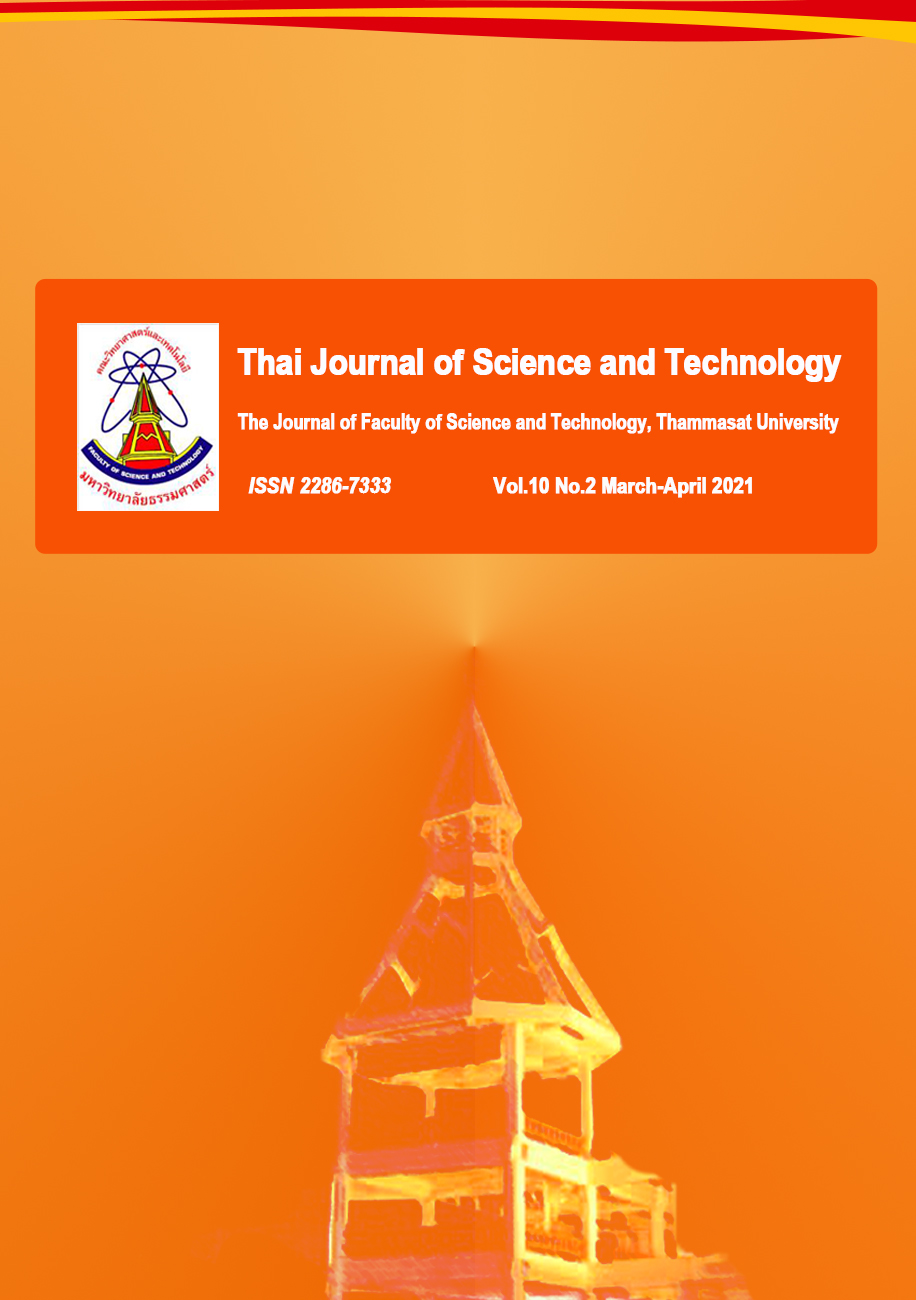Morphological and Molecular Identification of the Predatory Nematode, Mononchoides (Nematoda: Diplogasterida) from Thailand
Main Article Content
Abstract
Predatory nematodes; Mononchoides are the beneficial nematodes that feed on small organisms or other nematodes. Mononchoides population collected from guava orchards and para rubber plantation in Thailand was characterized by morphological and molecular techniques. Mononchoides specie is characterized by a dorsal claw-like tooth; 7-8 µm wide and 3-4 µm long, long body (540-650 µm), didelphic-amphidelphic reproductive system and a relatively short filiform tail (40-50µm long). Genetic analysis of Mononchoides based on species-specific primers and sequence on the ribosomal DNA. This molecular diagnosis using Mnc1, Mnc3 and Mn28s primers were confirmed by nucleotide sequences that shared 100% similarity with the known nematode sequences (FJ661080, LC210629, KT884893, LN827618, KJ877211, KF151166, KP067833) in GenBank database. The Mononchoides-specific primers have been developed to offered a rapid species identification approach for further analysis and management.
Article Details

This work is licensed under a Creative Commons Attribution-NonCommercial-NoDerivatives 4.0 International License.
บทความที่ได้รับการตีพิมพ์เป็นลิขสิทธิ์ของคณะวิทยาศาสตร์และเทคโนโลยี มหาวิทยาลัยธรรมศาสตร์ ข้อความที่ปรากฏในแต่ละเรื่องของวารสารเล่มนี้เป็นเพียงความเห็นส่วนตัวของผู้เขียน ไม่มีความเกี่ยวข้องกับคณะวิทยาศาสตร์และเทคโนโลยี หรือคณาจารย์ท่านอื่นในมหาวิทยาลัยธรรมศาสตร์ ผู้เขียนต้องยืนยันว่าความรับผิดชอบต่อทุกข้อความที่นำเสนอไว้ในบทความของตน หากมีข้อผิดพลาดหรือความไม่ถูกต้องใด ๆ
References
Ahmad, W., & Jairajpuri, M.S. (2010). Mononchida: The predatory soil nematodes. Aligarh Muslim University, India.
Alexander, P., Rajanikanth, C.D., Bacon, C.D., & Bailey, C.D. (2007). Recovery of plant DNA using a reciprocating saw and silica-based columns. Molecular Ecology Notes, 7(1), 5-9.
Bhadury, P., Austen, M.C., Bilton, D.T., Lambshead, P.D., Rogers, A.D., & Smerdon, G.R. (2006). Molecular detection of marine nematodes from environmental samples: overcoming eukaryotic interference. Aquatic Microbial Ecology, 44, 97-103.
Bilgrami, A., & Gaugler, R. (2005). Feeding behaviour of the predatory nematodes Laimydorus baldus and Discolaimus major (Nematoda: Dorylaimida). Nematology, 7(1), 11-20.
Bilgrami, A., Brey, C., & Gaugler, R. (2008). First field release of a predatory nematode, Mononchoides gaugleri (Nematoda: Diplogastrida), to control plant-parasitic nematodes. Nematology, 10(1), 143-146.
Calaway, W.T., & Tarjan, A.C. (1973). A Compendium of the Genus Mononchoides Rahm, 1928 (Diplogastrinae: Nematoda). Nematology, 5(2), 107-116.
Cobb, N.A. (1918). Estimating the nematode populations of soil. USDA Technical Circular 1, p. 48.
Fauzia, M.S., Jairajpuri, S., & Khan, Z. (1998). Biocontrol potential of Mononchoides longicaudatus on Meloidogyne incognita on tomato plants. International Journal of Nematology, 8(1), 89–91.
Ferris, H. (2007). Nematode Morphometric Parameters. Retrieved from http://plpnemweb.ucdavis.edu/nemaplex/, August 8, 2016.
Griffiths, B.S., Donn, S., Neilson, R., & Daniell, T.J. (2006). Molecular sequencing and morphological analysis of a nematode community. Applied Soil Ecology, 32(2), 325-337.
Palang, K. (1966). A taxonomic study on plant parasitic and predaceous nematodes inhabiting rice fields in Thailand. (Master’s Degree). Kasetsart University, Thailand.
Khan, Z., & Kim, Y.H. (2005). The predatory nematode, Mononchoides fortidens (Nematoda: Diplogasterida), suppresses the root-knot nematode, Meloidogyne arenaria, in potted field soil. Biological Control, 35, 78–82.
Koohkan, M., Shokoohi, E., & Abolafia, J. (2014). Study of some mononchids (Mononchida) from Iran with a compendium of the genus Anatonchus. Tropical Zoology, 27(3), 88-127.
Naem, S., Pagan, C., & Nadler, S.A. (2010). Structural restoration of nematodes and acanthocephalans fixed in high percentage alcohol using Dess solution and rehydration. Parasitology, 96(4), 809-811.
Olia, M., Ahmad, W., Araki, M., & Minaka, N. (2009). Molecular characterization of some species of Mylonchulus (Nematoda: Mononchida) from Japan and comments on the status of Paramylonchulus and Pakmylonchulus. Nematology, 11(3), 337-342.
Osman, G.Y. (1988). Studies on the potential use of the predator Diplogaster sp. (Nematoda, Diplogasteridae) on certain root parasitic nematodes. Anzeiger fur Schadlingskunde Pflanzenschutz Umweltschutz, 61, 70–73.
Rozen, S., & Skaletsky, H. (2000). Primer3 on the WWW for general users and for biologist programmers. In: Bioinformatics Methods and Protocols (eds Krawetz S, Misener S), pp. 365–368. Humana Press, Totowa, NJ. http://fokker.wi.mit.edu/primer3/.
Shokoohi, E., Seddiqi, E., Panahi, H., & Abolafia, J. (2015). New isolate of Mononchoides composticola Steel, Moens, Scholaert, Boshoff, Houthoofd & Bert, 2011 (Nematoda: Neodiplogasteridae) from Iran. Zootaxa, 4044(1), 141-150.
Steel, H., Moens, T., Scholaert, A., Boshoff, M.C., Houthoofd, W., & Bert, W. (2011). Mononchoides composticola n. sp. (Nematoda: Diplogasteridae) associated with composting processes: morphological, molecular and autecological characterization. Nematology, 13(3), 347-363.
Thompson, J.D., Higgins, D.G., & Gibson, T.J. (1994). CLUSTAL W: improving the sensitivity of progressive multiple sequence alignment through sequence weighting, position-specific gap penalties and weight matrix choice. Nucleic Acids Research, 22, 4673-4680.
Troccoli, A., Oreste, M., Tarasco, E., Fanelli, E., & Luca, F.D. (2015). Mononchoides macrospiculum n. sp. (Nematoda: Neodiplogastridae) and Teratorhabditis synpapillata Sudhaus, 1985 (Nematoda: Rhabditidae): nematode associates of Rhynchophorus ferrugineus (Oliver) (Coleoptera: Curculionidae) in Italy. Nematology, 17, 953-966.
Waite, I.S., O'Donnel, A.G., Harrison, A., Davies, J.T., Colvan, S.R., Ekschmitt, K., Dogan, H., Wolters, V., Bongers, T., Bongers, M., Bakonyi, G., Nagy, P., Papatheodorou, E.M., Stamou, G.P., & Boström, S. (2003). Design and evaluation of nematode 18S rDNA primers for PCR and denaturing gradient gel electrophoresis (DGGE) of soil community DNA. Soil Biology and Biochemistry, 35, 1165–1173.


